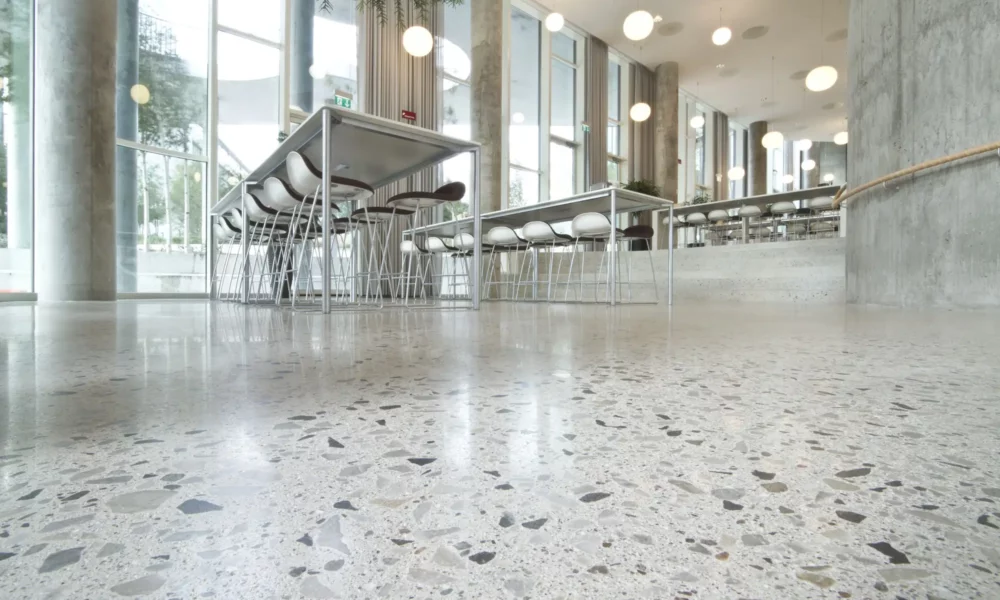Transform Your Space with Decorative Concrete

Concrete is no longer just a dull, gray material reserved for industrial buildings or backyard patios. With decorative concrete, you can elevate both interior and exterior spaces into artful designs that impress and endure. From textured stamped concrete to vibrant concrete staining, decorative concrete is redefining how we think about flooring, walls, and other surfaces.
This blog will explore the various types of decorative concrete, their benefits, and how you can use them creatively for your home or commercial projects. By the end, you’ll see why decorative concrete is not just functional—but a statement of style.
What Is Decorative Concrete?
Decorative concrete refers to the application of design techniques and finishes to plain concrete to enhance its aesthetic appeal while maintaining its strength and durability. This includes processes like stamping, staining, and resurfacing to make concrete look like materials such as brick, stone, or wood or to achieve unique designs and textures.
Whether you want a modern, sleek look for your home or a rustic, natural theme for your outdoor spaces, decorative concrete options allow you to flex your creative muscles without compromising functionality.
Why Choose Decorative Concrete?
Decorative concrete offers a host of benefits that make it an excellent choice for both residential and commercial spaces. Here’s why it’s a popular pick among homeowners and business owners alike:
1. Durability Meets Beauty
Concrete is one of the toughest materials available, able to withstand wear and tear from heavy foot traffic, harsh weather, and more. Decorative concrete retains this durability while also adding visually pleasing, high-end aesthetics.
2. Cost-Effective
Decorative concrete solutions like stamped concrete or concrete resurfacing are often much less expensive than installing high-end materials such as granite, marble, or wood. Plus, their long lifespan means you’ll save on repairs and replacements in the long run.
3. Low Maintenance
Once sealed properly, decorative concrete is easy to maintain. Regular sweeping and occasional resealing are typically all you need to keep your surfaces looking fresh.
4. Eco-Friendly Option
By enhancing the aesthetics of existing concrete through techniques like concrete staining, you minimize waste and reduce the need for additional material production.
5. Versatility
Whether you’re working on a driveway, patio, pool deck, or even an indoor floor, decorative concrete can be customized to fit your specific needs and tastes.
Popular Decorative Concrete Techniques
Not all decorative concrete is the same. Different techniques offer different benefits and aesthetics, so the right choice will depend on your project goals and space requirements.
1. Stamped Concrete
Stamped concrete is one of the most popular decorative concrete techniques. It involves pressing molds or stamps into freshly-poured concrete to replicate the texture and appearance of materials like stone, brick, or wood. This makes it a cost-effective alternative to expensive paving materials.
Where to Use It:
- Outdoor patios
- Driveways
- Pool decks
- Commercial walkways
Stamped concrete stands out for its ability to mimic high-end materials at a fraction of the cost, all while retaining the durability of traditional concrete.
2. Concrete Staining
Concrete staining is a technique that adds rich colors to your concrete surfaces, resulting in a more vibrant and polished appearance. Stains can be acid-based, producing natural earth tones, or water-based, offering a broader spectrum of colors.
Where to Use It:
- Indoor floors
- Retail spaces
- Restaurants and cafes
- Garage flooring
The best part about concrete staining? It penetrates deep into the material, ensuring the vibrant colors are fade-resistant, even with heavy use.
3. Concrete Resurfacing
If your existing concrete shows signs of wear and tear, resurfacing can give it new life. Concrete resurfacing involves applying a fresh, durable overlay to an old surface, which can then be polished, stamped, or stained to achieve your desired look.
Where to Use It:
- Cracked driveways
- Aging patios
- Indoor floors that require a modern update
Resurfacing is an excellent way to address imperfections without removing and replacing the old concrete entirely, saving you time and money.
4. Engraving
Engraving concrete involves cutting patterns and designs directly into the surface of hardened concrete. This creates an embossed, textured look perfect for creating unique geometric designs or even custom logos.
Where to Use It:
- Entryways
- Office lobbies
- Outdoor courtyards
Engraving adds a level of sophistication and personalization difficult to achieve with other materials.
5. Polished Decorative Concrete
Polished concrete is achieved by grinding down the surface to a smooth, reflective finish, often with the addition of dyes or stains to add dimension. This process not only enhances the floor’s appearance but also strengthens it against wear and tear.
Where to Use It:
- Modern homes
- Office spaces
- Industrial-style interiors
Creative Applications of Decorative Concrete
The versatility of decorative concrete means it can be used in ways you may not have imagined. Here are some creative ideas for using decorative concrete to transform your spaces:
- Bathrooms: Use concrete staining for a spa-like feel, or opt for polished concrete in modern or industrial-style bathrooms.
- Kitchens: Concrete countertops are not only durable but can be customized through staining or stamping for a stunning statement piece.
- Outdoor Living Spaces: Combine stamped concrete with natural elements for a rustic patio that blends beautifully with your landscape.
- Walls: Decorative concrete isn’t limited to floors. Add texture and color to interior or exterior walls for a unique architectural look.
How to Get Started with Decorative Concrete
Want to incorporate decorative concrete into your next project? Here are a few steps to take:
1. Identify Your Goals
Consider what you want to achieve with decorative concrete. Is it a modern, industrial vibe? Or a nature-inspired outdoor space?
2. Choose the Right Technique
Research various techniques like stamping, staining, or resurfacing to determine which best fits your vision. For instance, if you want a rustic, natural look, stamped concrete is a great choice.
3. Hire an Expert
Decorative concrete requires expertise to achieve professional-level results. Be sure to work with a trusted contractor that specializes in the processes you’re interested in.
4. Maintenance Plan
Once your project is complete, establish a simple maintenance routine to keep your surfaces in excellent condition for years to come.
Enhancing Your Space While Saving Costs
Decorative concrete is the perfect blend of art and functionality. Its ability to transform spaces while offering significant durability and cost savings makes it an unbeatable choice for any project. Whether you’re looking to renovate your home, build something new, or upgrade commercial spaces, the possibilities with decorative concrete in Tuscola are practically endless.
Are you ready to bring your vision to life? Start exploring your decorative concrete options now and create a space that inspires every day.





